Orangutans are great apes native to the tropical rainforests, specifically on the Southeast Asian islands of Borneo and Sumatra. Read on to find out some very cool facts about orangutans.

What Do Orangutans Look Like?
Orangutans are shaped like apes with shaggy reddish fur and grasping hands and feet. Their arms are much stronger and longer than their legs and can reach 2 meters or 6 feet in length. In fact, when they stand, their arms are long enough to touch their ankles.
These magnificent mammals measure 1.2 meters to 1.5 meters tall, or 4 to 5 feet, and weigh up to 100 kilograms, or 220 pounds. They have a relatively long arm span, even longer than their height. Some males have been known to stretch their arms 2 meters from fingertip to fingertip. This length is perfect for hooking onto branches and helping them travel from tree to tree.
There are two types of mature male orangutans: flanged and unflanged males. Unflanged males appear similar to females in size and face shape. The more dominant flanged males, on the other hand, are much bigger than females and, in addition to cheek pads called flanges, they have a large throat sac that helps them bellow their long, deep calls.
Habitat of Orangutans
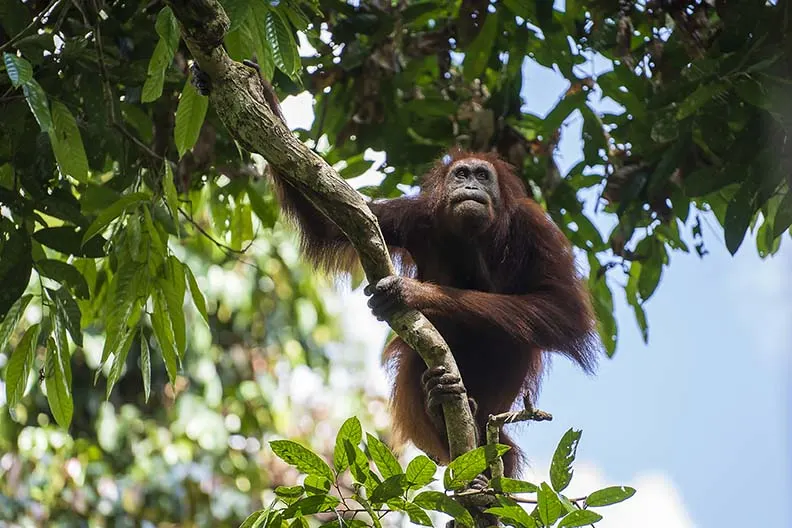
They primarily live in trees, making them the largest arboreal animal on Earth. They make nests in trees of vegetation to sleep at night and rest during the day.
Facts About Orangutans' Diets
Orangutans are classified as omnivores, but they are mainly known for feasting on leaves and wild fruits like lychees, mangosteens, and figs. Only occasionally do orangutans eat insects such as ants and termites, as well as bird eggs. Orangutans find the water they need for drinking up in the trees, be it in hollows, on leaves, or even on their fur after a rain.
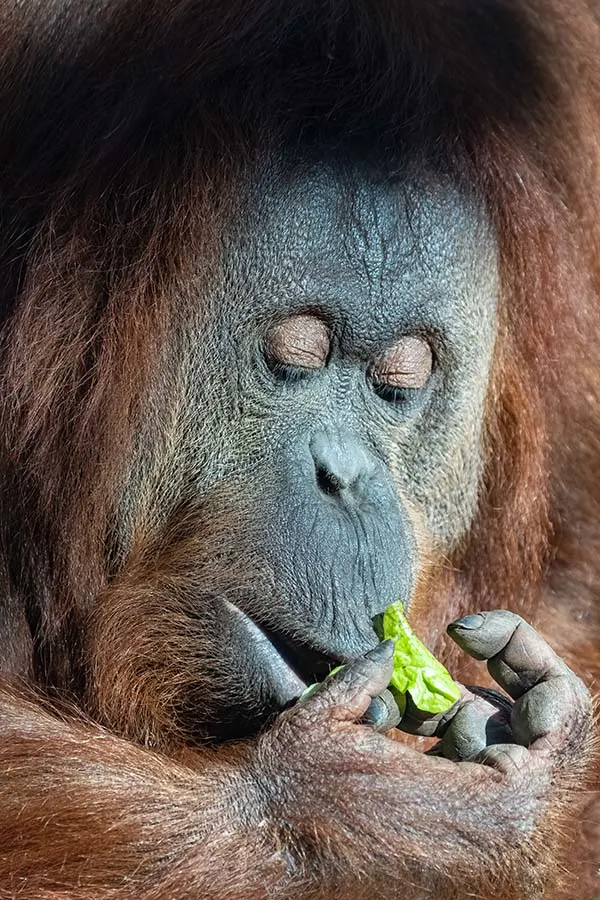
Facts About Baby Orangutans
Infant orangutans stay close to their mothers for a long time. They don’t leave their moms until they are between 10 and 12 years old. For the first two years of their lives, they depend entirely on their mother for food and transportation.
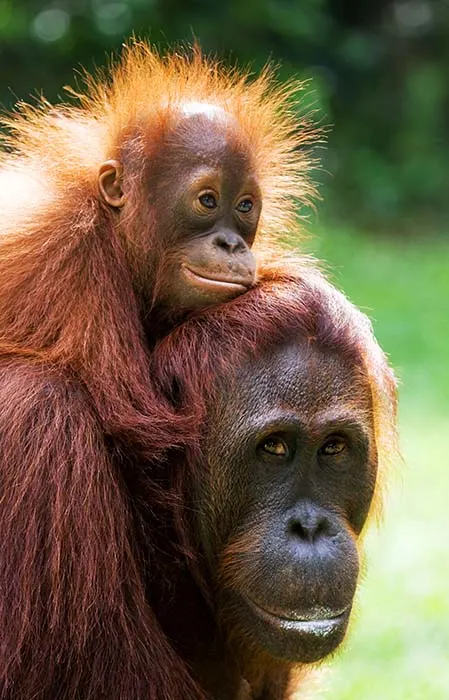
The babies nurse until they are about six years old. In mammals, we often don't see such a long association between a mother and her babies. Only humans have a stronger relationship with their mothers. This is one of the most interesting facts about orangutans!
Classification/Taxonomy of Orangutans
Here is the orangutan’s scientific classification.
Kingdom: Animalia
Phylum: Chordata
Class: Mammalia
Order: Primates
Suborder: Haplorhini
Infraorder: Simiiformes
Family: Hominidae
Subfamily: Ponginae
Genus: Pongo
History
Orangutans were initially considered to be one species. However, there are three orangutan species: Bornean, Sumatran, and Tapanuli. Bornean and Sumatran orangutans differ a little in appearance and behavior. While both have shaggy reddish fur, Sumatran orangutans have longer facial hair. The Bornean orangutan also has a wider face and larger throat pouch than the Sumatran orangutan. The third species of orangutan was announced in November of 2017.
Why Are Orangutans Endangered?
Unfortunately, all three orangutan species are considered critically endangered due to human activities such as poaching, habitat destruction, deforestation, palm oil plantations, and the illegal pet trade. Luckily, several conservation and rehabilitation organizations are dedicated to ensuring that orangutans can survive in the wild.
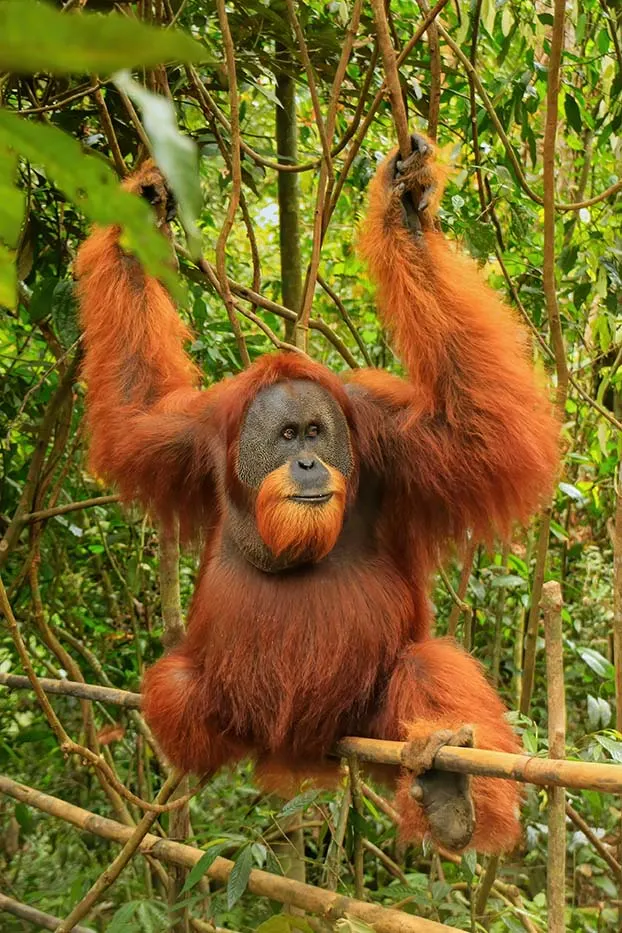
How Long Does an Orangutan Live?
Orangutans, able to live up to 50 years in the wild, have the slowest known life histories of any mammal. They take the longest time growing up and are the slowest to reproduce.
What Sound Does an Orangutan Make?
To hear what sound an Orangutan makes, click on this audio file.
Interesting Facts About Orangutans
- Although the word orangutan may sound like a reference to the orangutan’s orange-colored hair, it is a combination of two Malaysian words, “orang,” meaning “person” and “hutan,” meaning “forest.” The word Orangutan translates to “person of the forest.”
- The orangutan is the only great ape that does not live in large groups. Seasonally, groups of adults may come together at select fruit trees, and young females may “hang out” together for a few days at a time, but mostly these “people of the forest” are loners.
- Known as long calls, orangutans make a booming series of shouts that sometimes can travel for over a mile. The male orangutan’s long call serves several purposes. He can use it to let females know where he is, and he can warn other males to keep them from entering his territory.
- Orangutans are among the most intelligent primates. In fact, they are known to share 96.4% of their genes with human beings, making them the closest relative to us in the animal kingdom after apes.
- Orangutans can make simple tools such as ones to scratch themselves. They have been seen using leafy branches as shelter from the rain and sun. They even drape large leaves over themselves like a poncho. They often use branches as tools during insect foraging, honey collection, and as protection against stinging insects.
- A group of orangutans is called a “congress.”
- The orangutan is the only great ape native to Asia.
- Orangutans love durian fruit, which smells like pungent garlic.
- In 2011, scientists from the University of Manchester spent an entire year observing, documenting, and filming orangutans building nests. Their nest-building skills are more complex than any other non-human great apes, and the techniques are carefully taught from mother to youngster. They select specific types of limbs when constructing the base of the nest, smaller, more flexible branches for the sides, and even have multiple additional structures they may build such as blankets, pillows, and roofs.
- Males generally grow to at least two times the weight of females.
- Tigers are the most significant predator of orangutans in Sumatra. Because there are fewer tigers on Borneo, crocodiles are their biggest threat.
- With no more than 800 individuals in existence, the Tapanuli orangutan is the most endangered of all great apes.
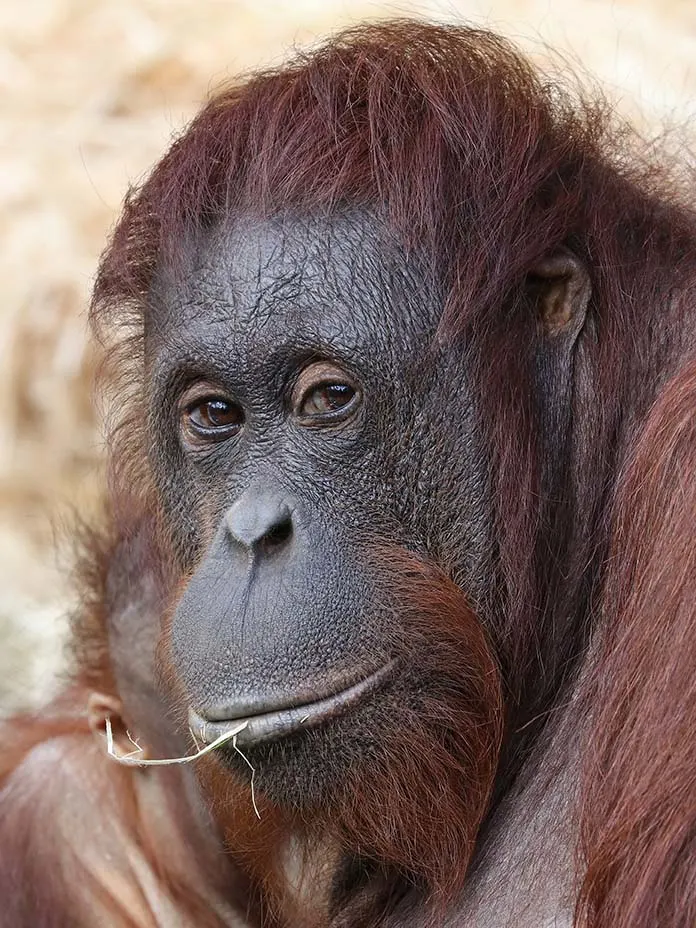
- Orangutans walk on their palms of fists instead of on their knuckles like gorillas and chimps. In the trees, their long curved fingers and toes serve as hooks to latch on from branch to branch in a style of locomotion called “brachiation.”
- Orangutans are incredibly dexterous and use both hands and feet while gathering food and traveling through the trees.
- An orangutan’s feet have opposable big toes, which have a grip strength four times that of a human hand.
- Orangutan females only give birth about once every eight years. This is the longest time between births of any mammal on earth.
- Orangutans are more solitary than other great apes and do not have as many vocal sounds like some of the more social primates. Orangutans rely more on facial expressions and body language to communicate.
- When water is difficult to reach, orangutans chew leaves to make a pulpy sponge to soak up the water.
- Orangutans have been known to engage in deceptive behavior to outwit their partners or their keepers when in captivity.
- Orangutans can identify more than 70 symbols for everyday objects, numbers, and commands, demonstrating a solid grasp of vocabulary and long-term memory.
- While orangutans are less aggressive than other primates, mature males fight with one another during mating. Fighting typically involves biting, scratching, and wrestling.
- Because orangutans eat so much fruit, they play an important role in spreading seeds. Once eaten, it takes about 75 hours for the seeds to travel through an orangutan’s digestive tract, where they are then excreted — intact — in their feces.
- In addition to eating, orangutans will carry large objects in their mouths while keeping their hands and feet free for traveling.
- Orangutans have jaws powerful enough to crack, crush, and chew fibrous foods such as fruit with spiny coverings, nuts, and tree bark.
- Orangutans' hips have full range of rotation similar to humans' shoulder joints. This allows their legs to move at almost any angle.
You don't want to miss learning about these cool mammals.
